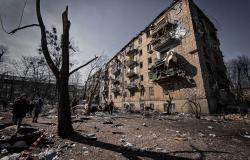How We Can Truly Build Back Better in Ukraine

Regenerating ecologies and economies for society: Challenges and guideposts for Ukraine and beyond.
With the proposed costs of post-conflict reconstruction in the war-torn country expected to exceed $1 trillion, delivering sustainable solutions is the key to delivering on this largess and avoiding the missteps of major reconstruction projects of the past.
How can a country be rebuilt sustainably in the aftermath of war? Aid agencies, development banks, and private businesses will all try to solve this riddle when the bullets stop in Ukraine and the long reconstruction process begins. With one trillion dollars in investment projects at stake, and now a just announced $66 billion in rebuild funds to already be provided between 2024 – 2027, now is the time to consider how to prioritize projects that not only bring the most efficient aid to Ukraine’s people, but also deliver sustainable development and climate resilience in the process.
The reconstruction of Ukraine might become one of the most difficult multilateral challenges of the 21st century. Russia’s invasion now carries a total war trajectory, with the destruction of civilian infrastructure a mainstay of the conflict. Moreover, the corresponding environmental destruction risks overwhelming a region in extreme fragility. Russia-backed separatists have triggered extensive environmental damage in eastern Ukraine through offensive actions, including flooding, poisoning of drinking water, and radiation contamination. This in turn triggered cascading environmental disasters in the highly industrialized area of Ukraine west of the Donetsk River.
Unfortunately, environmental attacks are escalating. With the recent destruction of the Nova Kakhovka Dam, the complexities of reconstructing Ukraine sustainably are made plain. The Kakhovka destruction wiped-out homes and agricultural livelihoods downriver, and made Ukraine more energy poor. There is now less renewable energy not only from the destruction of the hydroelectric power plant but also as dam water would be used to cool the nearby Zaporizhzhia Nuclear Power Station once it’s back online. Importantly, Nova Kakhovka is only one of many dams and other infrastructure destroyed to date, and analysts fear more such strikes to slow the growing Ukraine counter-offensive.
In the process, Ukraine’s environmental hazards and human health risks have grown exponentially. According to the EU-sponsored environmental destruction tracker EcoZagrosa, environmental damage to date carries a total cost of $200 billion. This does not include the cost of rebuilding or environmental remediation — estimated to be an additional $400 billion. More than 160,000 residential buildings have been damaged or destroyed, along with 150 bridges or overpasses, more than a dozen airports, several hundred large industrial production facilities including the Azovstal steel plant, and more than 50% of Ukraine’s energy infrastructure.
When a country’s infrastructure — renewable and conventional — is obliterated, two competing philosophies tend to emerge: those who want to rapidly rebuild the same systems to get a country “back to normal” as fast as possible, and those who wish to leapfrog old technologies in pursuit of a better system, albeit at the risk of a more expensive and longer reconstruction period. We’re here to say that this doesn’t have to be a choice: we can rebuild Ukraine’s infrastructure in a way that is cost effective, timely and more sustainable.
One key question is who becomes the arbiter of Ukraine’s future energy policy when the reconstruction process begins. For example, will states with powerful anti-nuclear advocates such as Germany prioritize the resuscitation of nuclear facilities which, before the invasion, provided 81 TWh or 55%, of Ukraine’s power (second globally to France)? Or will stakeholders like European environmental groups also have a say, who have advocated shutting down such hydroelectric plants because of the impact on ecosystems and have raised concerns about the potential safety issues of nuclear power plants?
Sustainability proponents are already debating what the “right” type of climate-friendly reconstruction will entail. Foremost among these is the nuclear question, a power generation source with a long history of both productivity and disaster in Ukraine. Climate activists have raised concerns that the Ukrainian government’s commitment to nuclear in their draft recovery plans are “inconsistent with sustainable development”. Others argue that “build back better” must include nuclear while focusing on decommissioning coal and gas-based electricity to constitute a realistic recovery timeline that is renewable-positive.
Moreover, the European Union’s focus on climate change mitigation through renewables investment and fossil fuel phaseouts is a key priority. Yet tying energy funding to conditionalities could undermine Ukraine’s own sovereignty and self-determination in charting its own post-invasion future, and risk multilateral fracture at the very moment when it will be most needed. And of course, with a timeline that needs to accommodate the possibility that reconstruction might begin next month or not until the next decade, adaptability in any plans are essential.
Therefore, we need to consider how to bring a footprint that allows reconstruction to be self-sustaining while also contributing to a more sustainable Ukraine. Based on our work in conflict zones and reconstruction, several critical factors will influence this agenda.
First, reconstruction costs will be immense. If the war ended today, a minimum estimate of costs is $411 billion, but with a new counter-offensive at hand and escalation of civilian attacks this figure may double or triple, depending upon if and how Russia withdraws from territory it occupies. Critical choices will then need to be made on what areas to remediate and how—that is, the expensive process of removing the toxic materials distributed in air, water, soil, or through solid hazardous waste. Doing it right will substantially inflate the final tally.
Thankfully, effectively planned enterprise investment can reduce rebuilding costs and provide essential livelihood benefits by promoting jobs, goods, and services. By assessing ecological risk and use of areas, and matching it to enterprises that can safely use the location with little remediation, businesses can more quickly and beneficially begin operating without adding to, and even reducing, the ecological burden of the war.
For example, solar panel arrays or wind farms can be sited in former industrial areas where toxic land can be utilized in alternative ways, reducing the extent and the cost of remediation. The US Environmental Protection Agency has begun using this method, termed ‘re-powering’, to reduce the costs of remediating contaminated sites across the country while providing a sustainable, non-human health impacting, and productive option for contaminated areas. Nature-based regenerative solutions can also be leveraged to restore damaged ecosystems and facilitate the development of new uses.
Second, reconstruction efforts deliver massive inflows of capital that risk enriching connected elites and sowing the seeds for later conflict by increasing inequalities and corruption. Post-conflict reconstruction efforts — from Iraq and Afghanistan to Nepal and Myanmar — are filled with cautionary tales of over-investment of a type promoted by international financial institutions that exacerbate communal tensions through poor planning. Worse, these entities often crowd out small scale alternatives through corruptive practices.
Therefore, investments in distributed, medium to small-scale, and local or locally-partnered infrastructure development projects like community solar energy can better promote post-conflict infrastructure resilience. Investing in them, whether through aid and/or private investment, return greater benefit to post-conflict areas by keeping more funding locally while producing more resilient and ecologically sustainable development. Even better, they have a track record of being more innovative, more nimble, and more quickly implemented than their mega project counterparts.
Third, the Ukrainian reconstruction effort will face a challenge in the timing of foreign aid versus private investment. During the so-called “buffer” period between peace and war – the ten years following the end of violent hostilities – Ukraine is likely to see a 40% increased risk of violent conflict while also seeing a sharp decrease in foreign aid at about year five. If Ukrainian reconstruction plays out in similar ways, then years six to ten from the end of hostilities will be the most dangerous for Ukraine to relapse into violence. Those years are also likely to be the ones during the buffer period in which Ukraine is best able to use outside funding.
A focus on sustainability combined with what we know about the buffer period should mean that foreign reconstruction aid after the end of hostilities should prioritize non-carbon emitting energy production. These will be the building blocks of lower-emission Ukrainian development, allow Ukraine to source private financing for the remainder of the at-risk buffer period, and help the ecosystems of Ukraine recover from the destruction of war more quickly than rebuilding conventional power alone could do. In short, “decentralized renewable systems can accelerate local economic development, advance environmental sustainability, and establish the foundations of better governance” in post-conflict settings of all types.
Donors providing reconstruction assistance to Ukraine, just like private entities looking to invest and operate in the aftermath, will have to help the country ensure that it can both rebuild quickly and create an infrastructure that does not contribute to, and is resilient to, both climate change and toxic pollution. Partnering with decentralized environment positive players carries the potential to truly “build back better” in a fashion that not only maximizes the benefits to the Ukrainian people, but also contributes to a more sustainable world.
Drew Marcantonio, Ph.D, is a researcher at the University of Notre Dame focused on regenerative livelihoods, environmental management and violence, and peacebuilding.
John Katsos, LLM, is an associate professor of business law, business ethics, and social responsibility at the American University of Sharjah.
Jason Miklian, Ph.D, is a senior researcher in business and peacebuilding at the Centre for Development and the Environment, University of Oslo.
Photo by Алесь Усцінаў


